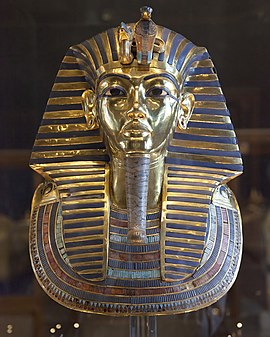
Back Toetankamen Afrikaans توت عنخ آمون Arabic توت عنخ امون ARZ Tutankamón AST Tutanxamon Azerbaijani توت انخ آمون AZB Тутанхамон Bashkir Tutankhamun BCL Тутанхамон Byelorussian Тутанхамон BE-X-OLD
| Tutankhamun | |||||||||||||||||||||||||||||||||||||||||||||||||||||||||||||||||||||||||||||||||||||||||||||||||||||||||||||||||||||||||||||
|---|---|---|---|---|---|---|---|---|---|---|---|---|---|---|---|---|---|---|---|---|---|---|---|---|---|---|---|---|---|---|---|---|---|---|---|---|---|---|---|---|---|---|---|---|---|---|---|---|---|---|---|---|---|---|---|---|---|---|---|---|---|---|---|---|---|---|---|---|---|---|---|---|---|---|---|---|---|---|---|---|---|---|---|---|---|---|---|---|---|---|---|---|---|---|---|---|---|---|---|---|---|---|---|---|---|---|---|---|---|---|---|---|---|---|---|---|---|---|---|---|---|---|---|---|---|
| Tutankhaten, Tutankhamen,[1] Tutankhamon | |||||||||||||||||||||||||||||||||||||||||||||||||||||||||||||||||||||||||||||||||||||||||||||||||||||||||||||||||||||||||||||
 Tutankhamun's golden funerary mask | |||||||||||||||||||||||||||||||||||||||||||||||||||||||||||||||||||||||||||||||||||||||||||||||||||||||||||||||||||||||||||||
| Pharaoh | |||||||||||||||||||||||||||||||||||||||||||||||||||||||||||||||||||||||||||||||||||||||||||||||||||||||||||||||||||||||||||||
| Reign | c. 1332 – 1323 BC, New Kingdom | ||||||||||||||||||||||||||||||||||||||||||||||||||||||||||||||||||||||||||||||||||||||||||||||||||||||||||||||||||||||||||||
| Predecessor | Neferneferuaten | ||||||||||||||||||||||||||||||||||||||||||||||||||||||||||||||||||||||||||||||||||||||||||||||||||||||||||||||||||||||||||||
| Successor | Ay (granduncle/grandfather-in-law) | ||||||||||||||||||||||||||||||||||||||||||||||||||||||||||||||||||||||||||||||||||||||||||||||||||||||||||||||||||||||||||||
| |||||||||||||||||||||||||||||||||||||||||||||||||||||||||||||||||||||||||||||||||||||||||||||||||||||||||||||||||||||||||||||
| Consort | Ankhesenamun (half-sister) | ||||||||||||||||||||||||||||||||||||||||||||||||||||||||||||||||||||||||||||||||||||||||||||||||||||||||||||||||||||||||||||
| Children | 2 | ||||||||||||||||||||||||||||||||||||||||||||||||||||||||||||||||||||||||||||||||||||||||||||||||||||||||||||||||||||||||||||
| Father | KV55 mummy,[6] identified as most likely Akhenaten | ||||||||||||||||||||||||||||||||||||||||||||||||||||||||||||||||||||||||||||||||||||||||||||||||||||||||||||||||||||||||||||
| Mother | The Younger Lady | ||||||||||||||||||||||||||||||||||||||||||||||||||||||||||||||||||||||||||||||||||||||||||||||||||||||||||||||||||||||||||||
| Born | c. 1341 BC | ||||||||||||||||||||||||||||||||||||||||||||||||||||||||||||||||||||||||||||||||||||||||||||||||||||||||||||||||||||||||||||
| Died | c. 1323 BC (aged c. 18–19) | ||||||||||||||||||||||||||||||||||||||||||||||||||||||||||||||||||||||||||||||||||||||||||||||||||||||||||||||||||||||||||||
| Burial | KV62 | ||||||||||||||||||||||||||||||||||||||||||||||||||||||||||||||||||||||||||||||||||||||||||||||||||||||||||||||||||||||||||||
| Dynasty | 18th Dynasty | ||||||||||||||||||||||||||||||||||||||||||||||||||||||||||||||||||||||||||||||||||||||||||||||||||||||||||||||||||||||||||||
Tutankhamun[a] or Tutankhamen[b] (c. 1341 BC – c. 1323 BC), was an ancient Egyptian pharaoh who ruled c. 1332 – 1323 BC during the late Eighteenth Dynasty of ancient Egypt. Born Tutankhaten, he was likely a son of Akhenaten, thought to be the KV55 mummy. His mother was identified through DNA testing as The Younger Lady buried in KV35; she was a full sister of her husband.
Tutankhamun acceded to the throne around the age of nine following the short reigns of his predecessors Smenkhkare and Neferneferuaten. He married his half-sister Ankhesenpaaten, who was probably the mother of his two infant daughters. During his reign he restored the traditional polytheistic form of ancient Egyptian religion, undoing the religious shift known as Atenism. His endowments and restorations of cults were recorded on the Restoration Stela. The cult of the god Amun at Thebes was restored to prominence and the royal couple changed their names to "Tutankhamun" and "Ankhesenamun", removing the -aten suffix. Additionally, he moved the royal court away from Akhenaten's capital, Amarna, and back to Memphis. He reestablished diplomatic relations with the Mitanni and carried out military campaigns in Nubia and the Near East. Tutankhamun was one of few kings worshipped as a deity during his lifetime. The young king likely began construction of a royal tomb in the Valley of the Kings and an accompanying mortuary temple but both were unfinished at the time of his death.
Tutankhamun died unexpectedly aged about 18; his health and the cause of his death have been the subject of much debate. In 2012 it was suggested he died from a combination of malaria and a leg fracture. With his royal tomb incomplete, he was instead buried in a small non-royal tomb adapted for his use. He was succeeded by his vizier Ay. Likely an old man when he became king, Ay's reign was short, being succeeded by Horemheb, Tutankhamun's commander-in-chief. Under Horemheb, the restoration of the traditional ancient Egyptian religion was completed; Ay and Tutankhamun's constructions were usurped and earlier Amarna Period rulers were erased.
In modern times, Tutankhamun is known for the 1922 discovery of his tomb by a team led by British Egyptologist Howard Carter sponsored by British aristocrat George Herbert. Although robbed anciently, it retained much of its original contents, including the king's undisturbed mummy. The discovery received worldwide press coverage; with over 5,000 artifacts, it gave rise to renewed public interest in ancient Egypt, for which Tutankhamun's mask, now preserved at the Egyptian Museum, remains a popular symbol. Some of his treasure has traveled worldwide with unprecedented response; the Egyptian government allowed tours beginning in 1961. The deaths of some individuals who were involved in the excavation have been popularly attributed to the "curse of the pharaohs" due to the similarity of their circumstances. Since the discovery of his tomb, he has been referred to colloquially as "King Tut".[8]
- ^ Clayton 2006, p. 128.
- ^ a b c d e Osing & Dreyer 1987, pp. 110–123.
- ^ a b c d "Digital Egypt for Universities: Tutankhamun". University College London. 22 June 2003. Retrieved 5 August 2006.
- ^ Leprohon 2013, p. 227.
- ^ a b c d e Leprohon 2013, p. 206.
- ^ Hawass et al. 2010, pp. 640–641.
- ^ a b "Tutankhamun or Tutankhamen". Collins English Dictionary. n.d. Retrieved 24 September 2014.
- ^ Schwarzer, Marjorie; Museums, American Association of (2006). Riches, Rivals & Radicals: 100 Years of Museums in America. American Association of Museums. p. 152. ISBN 978-1-933253-05-3. Retrieved 17 July 2022.
Cite error: There are <ref group=lower-alpha> tags or {{efn}} templates on this page, but the references will not show without a {{reflist|group=lower-alpha}} template or {{notelist}} template (see the help page).
© MMXXIII Rich X Search. We shall prevail. All rights reserved. Rich X Search
